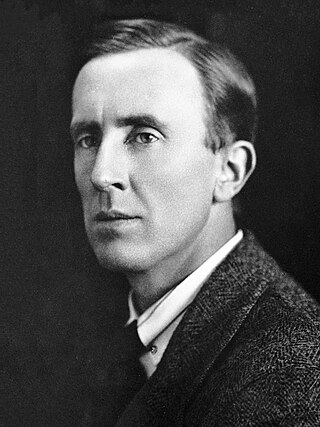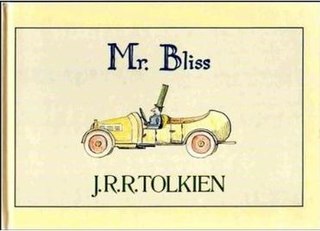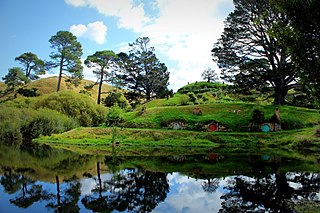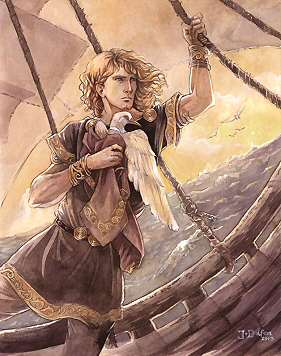
John Ronald Reuel Tolkien was an English writer and philologist. He was the author of the high fantasy works The Hobbit and The Lord of the Rings.
Hobbits are a fictional race of people in the novels of J. R. R. Tolkien. About half average human height, Tolkien presented hobbits as a variety of humanity, or close relatives thereof. Occasionally known as halflings in Tolkien's writings, they live barefooted, and traditionally dwell in homely underground houses which have windows, built into the sides of hills, though others live in houses. Their feet have naturally tough leathery soles and are covered on top with curly hair.

Gondor is a fictional kingdom in J. R. R. Tolkien's writings, described as the greatest realm of Men in the west of Middle-earth at the end of the Third Age. The third volume of The Lord of the Rings, The Return of the King, is largely concerned with the events in Gondor during the War of the Ring and with the restoration of the realm afterward. The history of the kingdom is outlined in the appendices of the book.

Bag End is the underground dwelling of the Hobbits Bilbo and Frodo Baggins in J. R. R. Tolkien's fantasy novels The Hobbit and The Lord of the Rings. From there, both Bilbo and Frodo set out on their adventures, and both return there, for a while. As such, Bag End represents the familiar, safe, comfortable place which is the antithesis of the dangerous places that they visit. It forms one end of the main story arcs in the novels, and since the Hobbits return there, it also forms an end point in the story circle in each case.
"The Scouring of the Shire" is the penultimate chapter of J. R. R. Tolkien's fantasy The Lord of the Rings. The Fellowship hobbits, Frodo, Sam, Merry, and Pippin, return home to the Shire to find that it is under the brutal control of ruffians and their leader "Sharkey", revealed to be the Wizard Saruman. The ruffians have despoiled the Shire, cutting down trees and destroying old houses, as well as replacing the old mill with a larger one full of machinery which pollutes the air and the water. The hobbits rouse the Shire to rebellion, lead their fellow hobbits to victory in the Battle of Bywater, and end Saruman's rule.
Tolkien fandom is an international, informal community of fans of the works of J. R. R. Tolkien, especially of the Middle-earth legendarium which includes The Hobbit, The Lord of the Rings, and The Silmarillion. The concept of Tolkien fandom as a specific type of fan subculture sprang up in the United States in the 1960s, in the context of the hippie movement, to the dismay of the author, who talked of "my deplorable cultus".

Mr. Bliss is a children's picture book by J. R. R. Tolkien, published posthumously in book form in 1982. One of Tolkien's least-known short works, it tells the story of Mr. Bliss and his first ride in his new motor-car. Many adventures follow: encounters with bears, angry neighbours, irate shopkeepers, and assorted collisions.
The works of J. R. R. Tolkien have generated a body of research covering many aspects of his fantasy writings. These encompass The Lord of the Rings and The Silmarillion, along with his legendarium that remained unpublished until after his death, and his constructed languages, especially the Elvish languages Quenya and Sindarin. Scholars from different disciplines have examined the linguistic and literary origins of Middle-earth, and have explored many aspects of his writings from Christianity to feminism and race.

The Shire Country Park is a country park in the south of Birmingham, England, taking its name from Tolkien's The Shire.

The Tolkien family is an English family of German descent whose best-known member is J. R. R. Tolkien, Oxford academic and author of the fantasy books The Hobbit, The Lord of the Rings and The Silmarillion.

Jeffrey Patrick Murray was an American fantasy artist and author best known for his illustrations of works by J.R.R. Tolkien and C.S. Lewis. His paintings, illustrations, stories, poems, and essays appear regularly in Tolkien and Inklings-oriented publications and in Catholic publications worldwide. He was Artist-in-Residence for the St. Austin Review, and was artist guest of honor at the 2006 Gathering of the Fellowship in Toronto along with Ted Nasmith. He was nominated for an Imperishable Flame award in 2006, and his work has been exhibited in the USA, Canada, the UK, and the Netherlands.

The Shire is a region of J. R. R. Tolkien's fictional Middle-earth, described in The Lord of the Rings and other works. The Shire is an inland area settled exclusively by hobbits, the Shire-folk, largely sheltered from the goings-on in the rest of Middle-earth. It is in the northwest of the continent, in the region of Eriador and the Kingdom of Arnor.

The Fellowship of the Ring is the first of three volumes of the epic novel The Lord of the Rings by the English author J. R. R. Tolkien. It is followed by The Two Towers and The Return of the King. The action takes place in the fictional universe of Middle-earth. The book was first published on 29 July 1954 in the United Kingdom. The volume consists of a foreword, in which the author discusses his writing of The Lord of the Rings, a prologue titled "Concerning Hobbits, and other matters", and the main narrative in Book I and Book II.

The plants in Middle-earth, the fictional world devised by J. R. R. Tolkien, are a mixture of real plant species with fictional ones. Middle-earth was intended to represent the real world in an imagined past, and in many respects its natural history is realistic.
"The Shadow of the Past" is the second chapter of J. R. R. Tolkien's bestselling fantasy work, The Lord of the Rings, which was published in 1954–1955. Tolkien called it "the crucial chapter"; the Tolkien scholar Tom Shippey labelled it "the vital chapter". This is because it represents both the moment that Tolkien devised the central plot of the book, and the point in the story where the protagonist, Frodo Baggins, and the reader realise that there will be a quest to destroy the Ring. A sketch of it was among the first parts of the book to be written, early in 1938; later that year, it was one of three chapters of the book that he drafted. In 1944, he returned to the chapter, adding descriptions of Gollum, the Ring, and the hunt for Gollum.

Glen GoodKnight (1941–2010) was the founder of the Mythopoeic Society and the editor of its journal, Mythlore between 1970 and 1998; in that time the publication grew from being a fan magazine to a peer-reviewed academic journal. He was an expert on and collector of the works of J. R. R. Tolkien and his fellow Inklings, C. S. Lewis and Charles Williams.

Oxonmoot is a conference and fan convention organized by The Tolkien Society devoted to celebrate and study the life and works of J. R. R. Tolkien. It takes place every year in Oxford, England, around 22 September, the date of Bilbo and Frodo Baggins's birthdays, also known as Hobbit Day.

Priscilla Mary Anne Reuel Tolkien was a British literary preservationist and the youngest child of J. R. R. Tolkien.
The architecture in Middle-earth, J. R. R. Tolkien's fictional world, is as varied as the Hobbit-holes of the Shire, the tree-houses of Lothlórien, the wooden halls of Rohan, and the stone dwellings and fortifications of Minas Tirith, capital of Gondor. Tolkien uses the architecture in each place, including its interior design, to provide clues to each people's character. The Hobbit Bilbo Baggins's cosy home, Bag End, described in his 1937 children's book The Hobbit, establishes the character of Hobbits as averse to travelling outside the Shire. In his fantasy novel The Lord of the Rings, Lothlórien demonstrates the close integration of the Elves with their natural environment. The King of Rohan's hall, Meduseld, indicates the Rohirrim's affinity with Anglo-Saxon culture, while Gondor's tall and beautiful stone architecture was described by Tolkien as "Byzantine". In contrast, the Dark Lord Sauron and the fallen Wizard Saruman's realms are damaged lands around tall dark towers.

Tolkien Society Awards, established in 2014, are an annual award presented by The Tolkien Society to "recognise excellence in the fields of Tolkien scholarship and fandom". The awards are held annually and are announced at the Annual Dinner during the Society's AGM and Springmoot weekend.



















